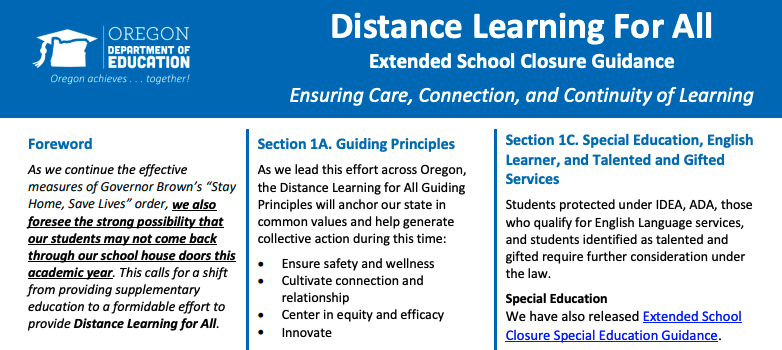As shelter in place guidelines continue throughout the nation and schools gear up with online education, many states are putting out guidelines to help teachers and families understand what that online education should look like.
Equity issues continue to be at the forefront of online education guidelines. Since it would be nearly impossible for most schools to provide the same education online as they do in the classroom, the content teachers are providing is taking some families by surprise.
Explore more topics in special education
“In the classroom, teachers need to simultaneously address the needs a wide variety of students, including TAG (talented and gifted) students, special needs students, ESL students, homeless students, and others. Unfortunately, most districts do not have online learning programs in place which do all these things, especially with robust, tested content, software, and policies.”
In the classroom, teachers need to simultaneously address the needs of a wide variety of students, including TAG (talented and gifted) students, special needs students, ESL students, homeless students, and others. Unfortunately, most districts do not have online learning programs in place which do all these things, especially with robust, tested content, software, and policies. Soon after states began to contemplate what the school year might look like with physical schools closed, it became clear that K-12 education was going to look very different online. One of the first big differences seen all over the country is the adoption of much more flexible grading principles. To help address equity challenges, online education in this circumstance will be a supplemental education, not a replacement for normal classroom education in the supported environment of a school. So deadlines, and indeed even grades, take a backseat to providing good online education in a safe, supportive environment during a crisis.
For example, on Mar 30, the Oregon Department of Education (DOE) announced it’s K-12 guidelines for the rest of the school year, called Distance Learning for All. Oregon DOE’s online learning strategy is built around 4 guiding principles: ensuring safety and wellness first and foremost, cultivating connections and relationships despite the lack of physical proximity, prioritizing equity and efficacy in every decision, and innovating to take advantage of new technology. Their proclamation notes that, “Faced with the challenge of school closure, we have an opportunity to harness new ways of relating, teaching, and learning through a distance learning model.” Oregon’s ODE hopes to maintain “an educational pathway” for each student by also encouraging students to develop “routines, expectations and priorities.”
Let’s Go Learn can help, providing best-in-class diagnostic reading and math assessment and instruction, giving each child a personalized learning path.


Leave A Comment